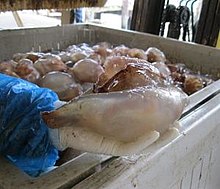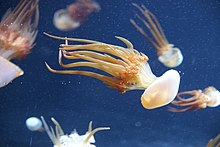Jellyfish as food



Some species of jellyfish are suitable for human consumption and are used as a source of food and as an ingredient in various dishes. Edible jellyfish is a seafood that is harvested and consumed in several East and Southeast Asian countries, and in some Asian countries it is considered to be a delicacy. Edible jellyfish is often processed into a dried product. Several types of foods and dishes may be prepared with edible jellyfish, including salads, sushi, noodles, and main courses. Various preparation methods exist.
Edible jellyfish
In China, some species of jellyfish in the
Production
In 2001, the annual global harvest of edible jellyfish was estimated to be around 321,000 metric tons (316,000 long tons; 354,000 short tons).[1] The most prominent countries involved in edible jellyfish production are Myanmar, China, Indonesia, Korea, Malaysia, the Philippines and Thailand.[2] In China, jellyfish larvae are reared in ponds before being released as juveniles into the sea to grow and mature.[11] In Southeast Asia, edible species of jellyfish may be harvested using various nets such as drift nets, scoop nets, set nets and hand nets, hooks and beach seines.[1] In 2001, the estimated annual catch in Southeast Asia in net weight was at around 169,000 metric tons (166,000 long tons; 186,000 short tons).[1] The amount of jellyfish caught annually in this region can vary significantly, and the fishing season for them is relatively short, at two to four months.[1]
Processing
Traditional methods of processing jellyfish into a
Jellyfish deteriorate rapidly at room temperature so processing starts soon after they are caught. The bell is separated from the dangling oral arms and both are washed in seawater before being scraped to remove the gonads and
Consumption
Jellyfish is consumed in several East Asian and Southeast Asian countries. In 2001, it was reported that Japan had annually imported between 5,400 and 10,000 tons of edible jellyfish from Indonesia, Malaysia, Myanmar, the Philippines, Singapore, Thailand, and Vietnam.[1] Dehydrated and pickled jellyfish is considered a delicacy in several Asian countries, including China, Korea, Vietnam, and Japan.[4][15] Dehydrated jellyfish can be prepared for eating by soaking it in water for several hours to rehydrate it, and then parboiling, rinsing and slicing it.[13]
Hazard
Consuming
Dishes
Jellyfish salad, a popular dish in some areas of Asia, may be prepared using cold marinated jellyfish that is thinly sliced.[17] Some Asian airlines serve jellyfish salad as a part of their meals.[13] Jellyfish sushi is consumed in Japan.[18] In Thailand, a crunchy style of noodle is produced using jellyfish.[18] The Japanese company Tango Jersey Dairy produces a vanilla and jellyfish ice cream,[19][20] prepared using cubes of diced Nomura's jellyfish (Echizen kurage in Japanese) soaked in milk.[20] It has been described as "slightly chewy". In Sarawak, the eastern part of Malaysia, a traditional delicacy by Melanau people also uses raw fresh jellyfish into a salad dish called Umai. [21] [20] Following the 2009 Japanese Nomura's jellyfish bloom, students in Obama, Fukui designed a Nomura Jellyfish powder to be used to make caramel sweets as part of a NASA-designed food safety management system established in the school.[22]
- Jellyfish dishes
-
A simple jellyfish salad
-
Jellyfish with shredded chicken at a restaurant
-
A jellyfish and roast duck salad
-
A Korean dish incorporating jellyfish
-
A jellyfish salad
-
A close-up view of Cantonese-style jellyfish
See also
References
- ^ ISBN 9789401007221.
- ^ ISBN 978-1-56676-736-1.
- ISBN 978-94-010-0722-1.
- ^ ISBN 978-1-59257-782-8.
- ^ Pitt, K.A. (1999). Ecology and Fishery of the Edible Jellyfish Catostylus Mosaicus (Scyphozoa, Rhizostomeae) in New South Wales, Australia. School of Biological Sciences, Faculty of Science, University of Sydney.
- ^ a b Pohl, Otto (May 21, 2002). "New Jellyfish Problem Means Jellyfish Are Not the Only Problem". The New York Times. Retrieved July 11, 2015.
- ISBN 978-0-226-02024-2.
- ISBN 978-0-643-09943-2.
- ^ S2CID 20719121.
- ^ a b c d Shanahan, Andrew (January 27, 2006). "Anatomy of a dish: Roast suckling pig with jellyfish, Yang Sing". The Guardian. Retrieved July 11, 2015.
- ISBN 978-1-4020-9749-2.
- ^ ISBN 978-0-7566-4053-8.
- ^ ISBN 978-1-4629-1676-4.
- ISSN 1750-3841.
- ISBN 978-1-57003-641-5.
- ^ Lee, Samantha (2015-10-09). "The 21 most dangerous foods in the world". Business Insider Singapore. Retrieved 2018-01-18.
- ^ Usborne, Simon (April 9, 2009). "Want to save the planet? Tuck in to some jellyfish and chips, squid sausages and algae burgers..." The Independent. Retrieved July 11, 2015.
- ^ a b "Is jellyfish sushi the future for fish lovers?". Marie Claire. March 5, 2009. Retrieved July 11, 2015.
- ^ "Gigantic jellyfish invade the Sea of Japan". Animal News: Animal Planet. April 26, 2010. Archived from the original on July 12, 2015. Retrieved July 11, 2015.
- ^ a b c Simpson, Aislinn (July 21, 2009). "Japan hit by invasion of giant Nomura's jellyfish". The Telegraph. Retrieved July 11, 2015.
- ^ Zainudin, Aniza. "Umai pembuka selera". Harian Metro.
- ^ "Space caramel made from giant jellyfish". Pink Tentacle. Retrieved 26 February 2016.
Further reading
- National Geographic (March 13, 1994). "Florida makes pitch for edible jellyfish". The Victoria Advocate. Retrieved July 11, 2015.
- "A Jellyfish Burger". Scientific American. 2009. Retrieved 12 July 2015.







